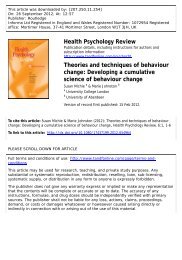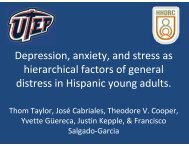2007 Final Program - Society of Behavioral Medicine
2007 Final Program - Society of Behavioral Medicine
2007 Final Program - Society of Behavioral Medicine
You also want an ePaper? Increase the reach of your titles
YUMPU automatically turns print PDFs into web optimized ePapers that Google loves.
SOCIETY <strong>of</strong> BEHAVIORAL MEDICINE<br />
Rapid Communications Posters Friday, March 23, <strong>2007</strong> • 6:30 PM-8:00 PM • Poster Session C<br />
Poster Session C:<br />
Health Communication and Technology;<br />
Measurement and Methods; Population Health,<br />
Policy and Advocacy; Prevention;<br />
Psychological and Person Factors in<br />
Health and Behavior Change<br />
Exhibit Hall A & B<br />
3417<br />
FEASIBILITY OF ADMINISTERING A SELF-HELP SMOKING<br />
CESSATION INTERVENTION VIA CELLULAR TELEPHONE<br />
Bradford W. Applegate, PhD, 1 William T. Riley, PhD 2 and Anahi<br />
Collado-Rodriquez, BA 1<br />
1<br />
PICS, Inc., Reston, VA and 2 National Institute <strong>of</strong> Mental Health,<br />
Bethesda, MD.<br />
Most cigarette smokers attempt to quit smoking on their own.<br />
There is a need to develop and refine technology to assist tobacco<br />
users to quit using empirically supported self-help treatments. This<br />
study presents data from a study that examined the feasibility <strong>of</strong><br />
implementing a Scheduled Gradual Reduction (SGR) smoking<br />
cessation program on cellular handsets, using JAVA-based cellular<br />
telephones, SMS text messaging, and HTTP data transfer to a central<br />
server.<br />
Method: A SGR program was adapted from earlier work and<br />
implemented on JAVA-enabled cellular handsets. The program uses<br />
a 7-day baseline <strong>of</strong> cigarette recording to determine baseline smoking<br />
behavior, and then institutes the SGR program that prompts the<br />
user to smoke at increasing intervals. The program also used a secure<br />
HTTP data transfer system to upload data to a central server to<br />
monitor program usage. Thirty five tobacco users pilot tested the<br />
system in a single group, open-label study. Subjects were enrolled,<br />
provided with a JAVA-enabled cellular phone, instructed to use the<br />
program to quit smoking, and returned for follow-up at 8 weeks.<br />
Outcome variables included number <strong>of</strong> days interacting with the<br />
program, 7-day abstinence and smoking behavior, and qualitative<br />
ratings <strong>of</strong> the program. The sample was 53% male, 54% White, 43 ±<br />
11 years <strong>of</strong> age, and smoked 22 ± 11 cigarettes per day (CPD).<br />
Results: Mean daily interaction <strong>of</strong> the program was 30 ± 22 days.<br />
Sixteen <strong>of</strong> 35 subjects reported a 24-hour quit, and 6.3% reported 7-<br />
day abstinence (biochemically verified) at eight weeks. Mean smoking<br />
rates were reduced by 50% to 11 ± 8 CPD at follow up, P < .001.<br />
Qualitative reports from subjects showed mixed usability ratings,<br />
with most reporting the program was easy to use, but that it reduced<br />
tobacco use too rapidly.<br />
Conclusions: Data from this study indicate that cellular handsets are<br />
a feasible means <strong>of</strong> delivering inexpensive but empirically supported<br />
self-help smoking cessation treatments.<br />
CORRESPONDING AUTHOR: Bradford W. Applegate, PhD,<br />
PICS, Inc., Reston, VA, 20148; bapplegate@lifesign.com<br />
~ 102 ~<br />
3418<br />
INTERNET MAY POSE AN EFFECTIVE CHANNEL FOR<br />
THE DELIVERY OF SUPPORTIVE HEALTH PROMOTION<br />
INTERVENTIONS TO SOCIALLY ANXIOUS ADULTS<br />
Jeanne M. Gabriele, MS, MA, 1 Deborah F. Tate, PhD, 2 Brian D.<br />
Carpenter, PhD, 1 Megan E. Jablonski 2 and Edwin B. Fisher, PhD 2<br />
1<br />
Psychology, Washington University, Saint Louis, MO and 2 Health<br />
Behavior and Health Education, University <strong>of</strong> North Carolina,<br />
Chapel Hill, NC.<br />
Previous research has shown that social anxiety can be a barrier<br />
to help-seeking and the utilization <strong>of</strong> in-person treatment services<br />
(Goodwin and Fitzgibbon, 2002). The present study examined<br />
whether social anxiety moderates the effect <strong>of</strong> e-coach support on<br />
weight loss in a 12-week weight loss e-coaching program. Forty<br />
participants (87.5% female, 65.0% white) attended an in-person<br />
baseline assessment in which weight was measured. Social anxiety<br />
was measured with the Brief Fear <strong>of</strong> Negative Evaluation Scale.<br />
Participants were randomized to an e-coach support or no e-coach<br />
support condition. All participants received weekly weight loss lessons<br />
and feedback graphs via e-mail. Participants in the e-coach support<br />
condition also received weekly e-mails providing individualized<br />
assistance in reaching weight loss goals. At the end <strong>of</strong> the intervention,<br />
weight was measured in an in-person assessment. Participants with<br />
high fear <strong>of</strong> negative evaluation (FNE) reported less weight loss<br />
support from family members and friends than participants with<br />
low FNE (p < .05). This finding suggests that individuals with social<br />
anxiety may have difficulty obtaining and/or receiving weight loss<br />
support. A hierarchical regression found an interaction between<br />
FNE and e-coach support when predicting weight loss (p < .05).<br />
For participants in the e-coach support conditions, FNE was related<br />
to greater weight loss (r = -.46, p < .05). This suggests that e-coach<br />
supportive interventions may by especially helpful for those high in<br />
social anxiety who may not access or who may not respond well to<br />
conventional health promotion interventions. In contrast, FNE was<br />
unrelated to weight loss for participants in the no e-coach support<br />
condition. These findings suggest that individuals with social anxiety<br />
may be in greater need <strong>of</strong> weight loss support and respond favorably<br />
to e-coach support provided over the internet.<br />
CORRESPONDING AUTHOR: Jeanne M. Gabriele, MS, MA,<br />
Health Behavior and Health Education, University <strong>of</strong> North Carolina<br />
at Chapel Hill, Chapel Hill, NC, 27599-7440; Jgabriele@wustl.edu<br />
3419<br />
DEVELOPMENT OF THE COMMUNICATION CHANNEL<br />
PREFERENCE INVENTORY<br />
Jennifer Doucet, Master <strong>of</strong> Arts, 1 Marimer Santiago, BA 1 and<br />
Wayne Velicer, PhD 1<br />
1<br />
University <strong>of</strong> Rhode Island, Kingston, RI; 2 University <strong>of</strong> Rhode<br />
Island, Kingston, RI and 3 University <strong>of</strong> Rhode Island, Kingston, RI.<br />
Interventions for health promotion have employed a number <strong>of</strong><br />
communication modalities. One potential method <strong>of</strong> improving<br />
intervention effectiveness is to identify an individual’s preferred<br />
communication channel and match the intervention to the channel.<br />
The Learning Styles research area has identified a range <strong>of</strong> learner<br />
preferences for assimilating and accommodating information.<br />
However, the internet and other advanced technologies were<br />
not included in the original measures. The goal <strong>of</strong> this study was

















